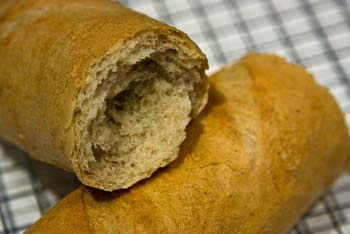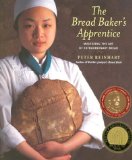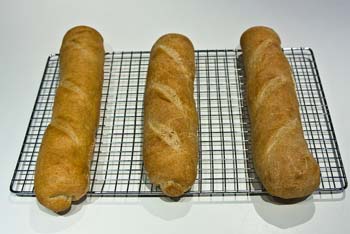Well, I finally did it. I purchased the bread baking book I had been considering. I have baked bread before, but have been clamoring for more information about the “why”. Without the “why”, the bread recipes read more like a list of strange actions designed merely to torture the would-be home baker. With the “why”, you understand what’s important and why all the effort is (or has the potential to be) worth it. With much glee this past week, I cracked into “The Bread Baker’s Apprentice: Mastering the Art of Extraordinary Bread
I hear it’s a sin, but this is the first of Peter Reinhart’s books I’ve ever picked up. He is an award-winning author and a baking instructor at Johnson and Wales University in Providence, Rhode Island, and something of an authority on bread.



From there, the real meat of the book begins. Reinhart leads you through the basics first – bread classification, baking tools, ingredients, how to knead, etc. Then he delves into an in-depth discussion of the twelve stages of bread. Did you know there were twelve? I did not. They are: Mis en Place, Mixing, Primary Fermentation, Punching down, Dividing, Rounding, Benching, Shaping and Panning, Proofing, Baking, Cooling, and finally Storing and eating. Throughout the discussion, he does a great job of being very thorough while still trying to explain what can be altered and to what effect.
At last, he offers up formulas. These include pre-ferments and sourdough seed cultures. They also include a wonderful array of breads: bagels, French bread, lavash, all-purpose white bread. The preparations are well-laid-out and generally include helpful photos illustrating steps and/or end results. In the outside column of each formula, he very helpfully lays out what he calls the bread profile (rich, standard dough; indirect method; commercial yeast) and the number of days to make it, complete with the amount of time required each day.
It was, in fact, very difficult to choose a first recipe to test. What I settled on finally was the Pain de Campagne – a fairly straight forward French country bread. It required a pâte fermentée – a stiff pre-ferment of flour, water, yeast, and salt that was allowed to sit overnight in the refrigerator to allow the flavors to develop. The next day, when it came time to shape the dough, I chose the batard or torpedo shape. As it happens, mine turned out looking more like squatty baguettes, so clearly there’s still work to be done on my shaping technique. The flavor, however, was pretty darn good. My crusts, particularly on the first loaf I baked (I had to do two batches since all three wouldn’t fit on my round pizza stone), were acceptable, though I’m guessing some work could be done there. Reinhart does take a fair bit of time explaining to you how best to try to replicate the conditions of a commercial oven at home – the baking stone attempts to replicate the nice even heating of a big stone or brick oven, and a pan full of water and steam sprayed on the oven walls is meant to replicate the burst of steam a commercial oven is capable of producing (providing extra time for the loaf to “spring” in the oven and helping to develop a beautiful crust). I expect that my crusts may improve as I get better at the steaming steps.

A note on testing these recipes. With the other cookbooks I’ve tested recipes from, I can rely on some amount of cooking experience to reasonably assume that my ineptitude is less of a factor than the author’s explanations or ingredient choices. With this bread book, however, I expect the opposite is likely to be true. Try to look at this as a demonstration of what a relative novice is capable of producing with the guidance of the text at hand.
So far, this book is an absolute joy. It’s precisely what I was looking for – the “why”. Over the coming weeks, I will try more of the recipes and let you know how it goes. In fact, today, I will begin (to attempt) to build my sourdough seed culture, and hopefully within a couple weeks, I’ll be gushing all about the Texas sourdough bread I’ve produced.